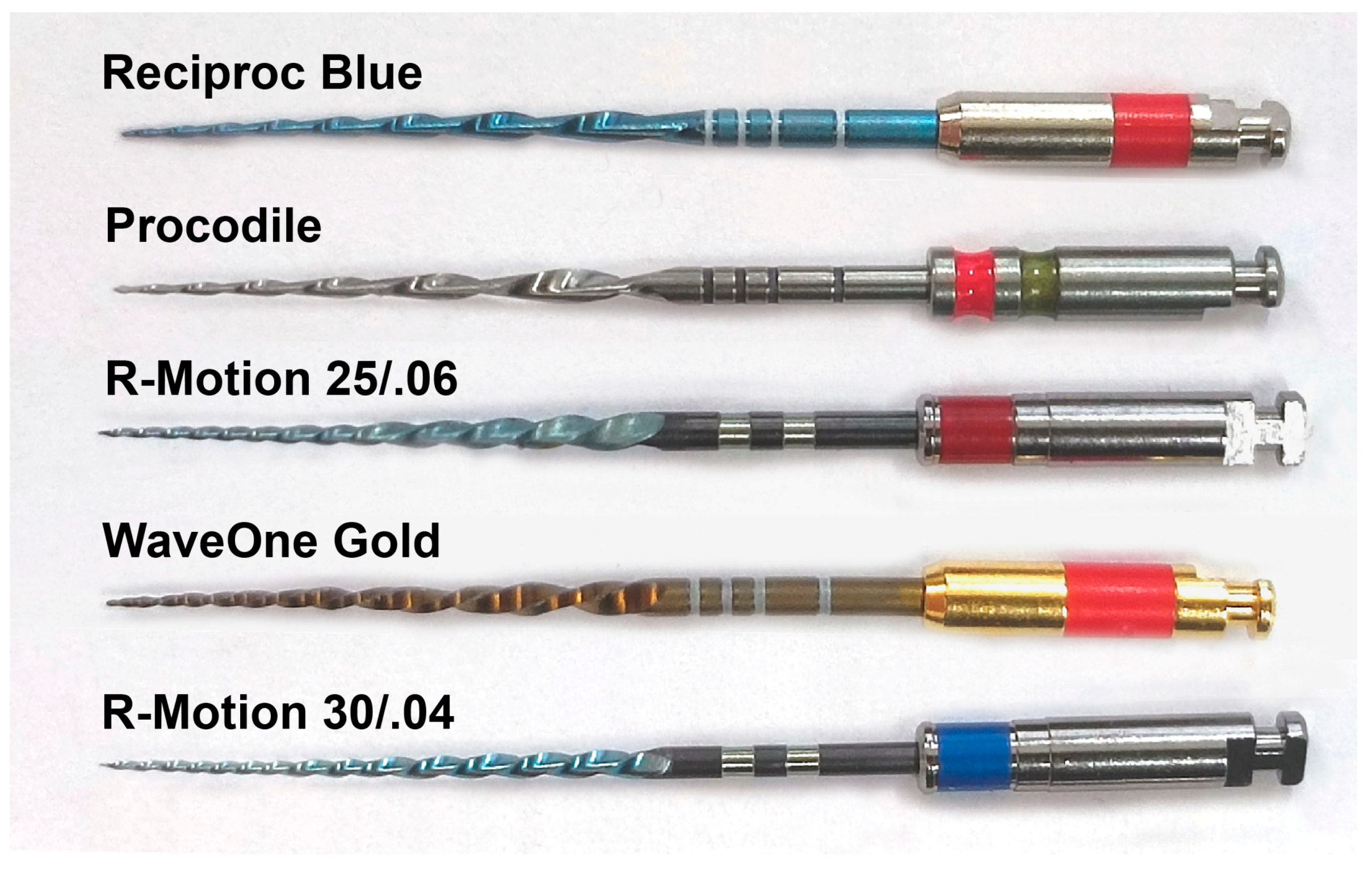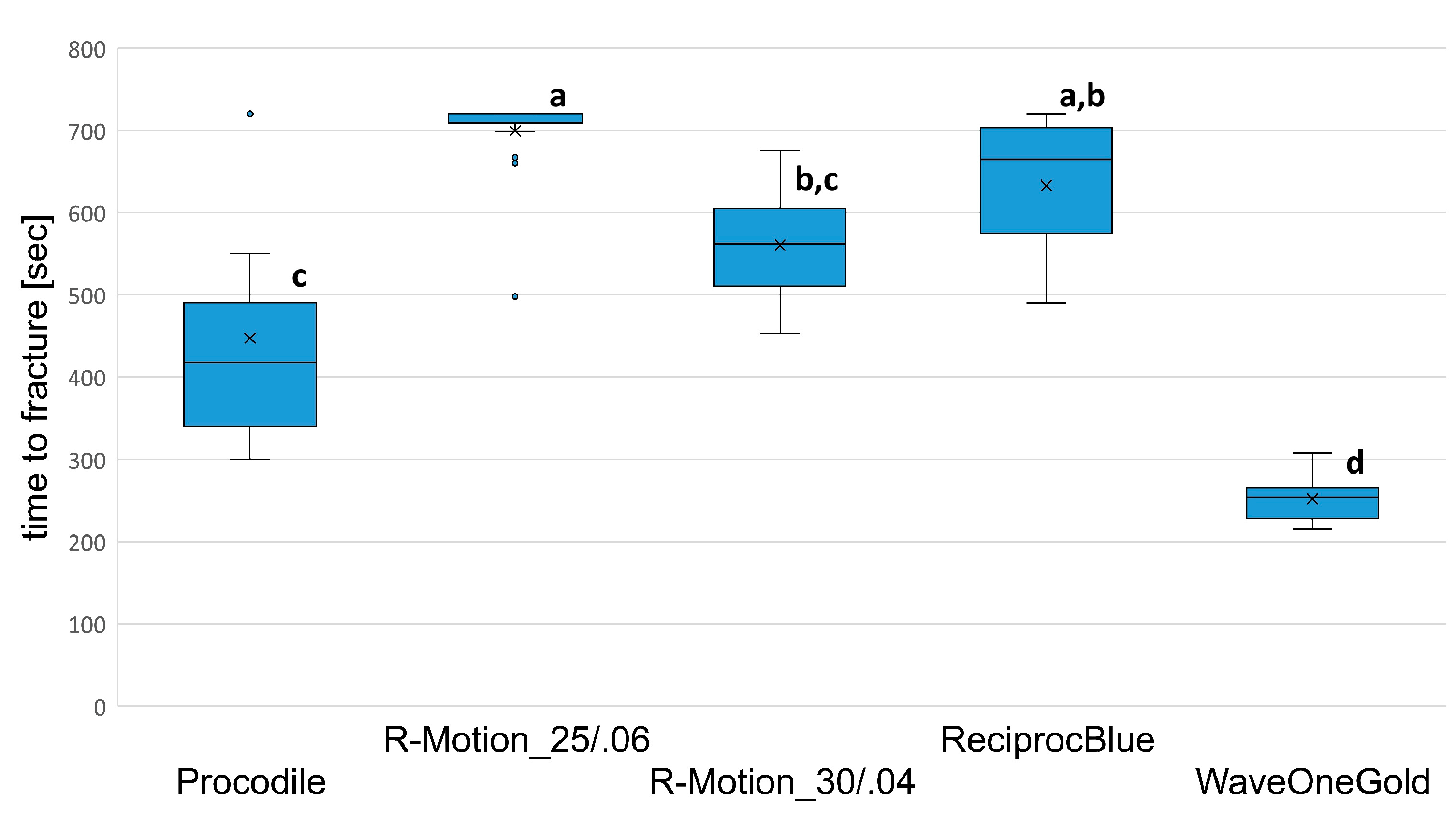Cyclic Fatigue of Different Reciprocating Endodontic Instruments Using Matching Artificial Root Canals at Body Temperature In Vitro
Abstract
1. Introduction
2. Materials and Methods
2.1. Sample Size Calculation
2.2. Artificial Canals
2.3. Testing Device
2.4. Analysis of the Fractured Instruments
2.5. Statistical Analysis
3. Results
3.1. Number of Fractured Instruments
3.2. Time to Fracture and NCF
3.3. Lengths of the Fractured Instruments
3.4. Fractographic Analysis
4. Discussion
5. Conclusions
Author Contributions
Funding
Institutional Review Board Statement
Informed Consent Statement
Data Availability Statement
Conflicts of Interest
References
- Gao, Y.; Gutmann, J.L.; Wilkinson, K.; Maxwell, R.; Ammon, D. Evaluation of the impact of raw materials on the fatigue and mechanical properties of ProFile Vortex rotary instruments. J. Endod. 2012, 38, 398–401. [Google Scholar] [CrossRef]
- Young, G.R.; Parashos, P.; Messer, H.H. The principles of techniques for cleaning root canals. Aust. Dent. J. 2007, 52, 52–63. [Google Scholar] [CrossRef]
- Peters, O.A. Current challenges and concepts in the preparation of root canal systems: A review. J. Endod. 2004, 30, 559–567. [Google Scholar] [CrossRef]
- Ebihara, A.; Yahata, Y.; Miyara, K.; Nakano, K.; Hayashi, Y.; Suda, H. Heat treatment of nickel–titanium rotary endodontic instruments: Effects on bending properties and shaping abilities. Int. Endod. J. 2011, 44, 843–849. [Google Scholar] [CrossRef]
- He, R.; Ni, J. Design improvement and failure reduction of endodontic files through finite element analysis: Application to V-taper file designs. J. Endod. 2010, 36, 1552–1557. [Google Scholar] [CrossRef]
- Anderson, M.E.; Price, J.W.; Parashos, P. Fracture resistance of electropolished rotary nickel-titanium endodontic instruments. J. Endod. 2007, 33, 1212–1216. [Google Scholar] [CrossRef]
- Kaval, M.E.; Capar, I.D.; Ertas, H.; Sen, B.H. Comparative evaluation of cyclic fatigue resistance of four different nickel-titanium rotary files with different cross-sectional designs and alloy properties. Clin. Oral. Investig. 2017, 21, 1527–1530. [Google Scholar] [CrossRef]
- Bürklein, S.; Zupanc, L.; Donnermeyer, D.; Tegtmeyer, K.; Schäfer, E. Effect of Core Mass and Alloy on Cyclic Fatigue Resistance of Different Nickel-Titanium Endodontic Instruments in Matching Artificial Canals. Materials 2021, 14, 5734. [Google Scholar] [CrossRef] [PubMed]
- Hülsmann, M.; Donnermeyer, D.; Schäfer, E. A critical appraisal of studies on cyclic fatigue resistance of engine-driven endodontic instruments. Int. Endod. J. 2019, 52, 1427–1445. [Google Scholar] [CrossRef] [PubMed]
- Council on Dental Materials and Devices (2013) ANSI/ADA Specification No 28. Root Canal Files and Reamers, Type K for Hand Use; American Dental Association: Chicago, IL, USA, 2013; Available online: https://www.techstreet.com/mss/products/preview/1820390 (accessed on 11 January 2024).
- ISO 3630–3631: 2019; Dentistry—Root Canal Instruments—Part 1: General Requirements and Test Methods. International Organization for Standardization (ISO): Geneva, Switzerland, 2019.
- Bürklein, S.; Maßmann, P.; Donnermeyer, D.; Tegtmeyer, K.; Schäfer, E. Need for Standardization: Influence of Artificial Canal Size on Cyclic Fatigue Tests of Endodontic Instruments. Appl. Sci. 2021, 11, 4950. [Google Scholar] [CrossRef]
- De-Deus, G.; Silva, E.J.; Vieira, V.T.; Belladonna, F.G.; Elias, C.N.; Plotino, G.; Grande, N.M. Blue thermomechanical treatment optimizes fatigue resistance and flexibility of the Reciproc files. J. Endod. 2017, 43, 462–466. [Google Scholar] [CrossRef] [PubMed]
- Cheung, G.S. Instrument fracture: Mechanisms, removal of fragments, and clinical outcomes. Endod. Topics. 2007, 16, 1–26. [Google Scholar] [CrossRef]
- Ruivo, L.M.; Rios, M.A.; Villela, A.M.; de Martin, A.S.; Kato, A.S.; Pelegrine, R.A.; Barbosa, A.F.A.; Silva, E.J.N.L.; Bueno, C.E.D.S. Fracture incidence of Reciproc instruments during root canal retreatment performed by postgraduate students: A cross-sectional retrospective clinical study. Restor. Dent. Endod. 2021, 46, e49. [Google Scholar] [CrossRef] [PubMed]
- Caballero-Flores, H.; Nabeshima, C.K.; Binotto, E.; Machado, M.E.L. Fracture incidence of instruments from a single-file reciprocating system by students in an endodontic graduate programme: A cross-sectional retrospective study. Int. Endod. J. 2019, 52, 13–18. [Google Scholar] [CrossRef]
- Bueno, C.S.P.; Oliveira, D.P.; Pelegrine, R.A.; Fontana, C.E.; Rocha, D.G.P.; Bueno, C.E.D.S. Fracture Incidence of WaveOne and Reciproc Files during Root Canal Preparation of up to 3 Posterior Teeth: A Prospective Clinical Study. J. Endod. 2017, 43, 705–708. [Google Scholar] [CrossRef]
- Pruett, J.P.; Clement, D.J.; Carnes, D.L., Jr. Cyclic fatigue testing of nickel-titanium endodontic instruments. J. Endod. 1997, 23, 77–85. [Google Scholar] [CrossRef]
- Faus-Llácer, V.; Hamoud-Kharrat, N.; Marhuenda Ramos, M.T.; Faus-Matoses, I.; Zubizarreta-Macho, Á.; Ruiz Sánchez, C.; Faus-Matoses, V. Influence of the Geometrical Cross-Section Design on the Dynamic Cyclic Fatigue Resistance of NiTi Endodontic Rotary Files—An In Vitro Study. J. Clin. Med. 2021, 10, 4713. [Google Scholar] [CrossRef]
- Tripi, T.R.; Bonaccorso, A.; Condorelli, G.G. Cyclic fatigue of different nickel-titanium endodontic rotary instruments. Oral. Surg. Oral. Med. Oral. Pathol. Oral. Radiol. Endod. 2006, 102, e106–e114. [Google Scholar] [CrossRef] [PubMed]
- Anderson, T.L.; Anderson, T.L. Fracture Mechanics: Fundamentals and Applications, 3rd ed.; CRC Press: Boca Raton, FL, USA, 2005. [Google Scholar] [CrossRef]
- Cheung, G.S.; Darvell, B.W. Fatigue testing of a NiTi rotary instrument. Part 2: Fractographic analysis. Int. Endod. J. 2007, 40, 619–625. [Google Scholar] [CrossRef]
- Silva, E.J.N.L.; Martins, J.N.R.; Ajuz, N.C.; Dos Santos Antunes, H.; Vieira, V.T.L.; Braz-Fernandes, F.M.; Belladonna, F.G.; Versiani, M.A. Design, metallurgy, mechanical properties, and shaping ability of 3 heat-treated reciprocating systems: A multimethod investigation. Clin. Oral. Investig. 2023, 27, 2427–2436. [Google Scholar] [CrossRef]
- Weissheimer, T.; Duarte, M.A.H.; Só, M.V.R.; da Rosa, R.A.; Espinosa, M.K.; Vivan, R.R.; Alcalde, M.P. Evaluation of cyclic and torsional fatigue resistance of several heat-treated reciprocating nickel-titanium instruments. Aust. Endod. J. 2023, 49, 524–529. [Google Scholar] [CrossRef]
- Keskin, C.; Inan, U.; Demiral, M.; Keleş, A. Cyclic Fatigue Resistance of Reciproc Blue, Reciproc, and WaveOne Gold Reciprocating Instruments. J. Endod. 2017, 43, 1360–1363. [Google Scholar] [CrossRef] [PubMed]
- Elsewify, T.; Elhalabi, H.; Eid, B. Dynamic Cyclic Fatigue and Differential Scanning Calorimetry Analysis of R-Motion. Int. Dent. J. 2023, 73, 680–684. [Google Scholar] [CrossRef] [PubMed]
- Hou, X.M.; Yang, Y.J.; Qian, J. Phase transformation behaviors and mechanical properties of NiTi endodontic files after gold heat treatment and blue heat treatment. J. Oral Sci. 2020, 63, 8–13. [Google Scholar] [CrossRef] [PubMed]
- Generali, L.; Malovo, A.; Bolelli, G.; Borghi, A.; La Rosa, G.R.M.; Puddu, P.; Lusvarghi, L.; Rota, A.; Consolo, U.; Pedullà, E. Mechanical Properties and Metallurgical Features of New Green NiTi Reciprocating Instruments. Materials 2020, 13, 3736. [Google Scholar] [CrossRef] [PubMed]
- Kasuga, Y.; Kimura, S.; Maki, K.; Unno, H.; Omori, S.; Hirano, K.; Ebihara, A.; Okiji, T. Phase transformation and mechanical properties of heat-treated nickel-titanium rotary endodontic instruments at room and body temperatures. BMC Oral Health 2023, 23, 825. [Google Scholar] [CrossRef] [PubMed]
- Elwakeel, M.S.A.A.; Hashem, A.A.R.; Fahmy, S.H.; Saber, S.M.; Plotino, G. The impact of composition, core metal mass and phase transformation behaviour on the dynamic cyclic fatigue of Ni-Ti files at different temperatures. G. Ital. Endod. 2022, 36, 101–109. [Google Scholar] [CrossRef]
- Di Nardo, D.; Gambarini, G.; Seracchiani, M.; Mazzoni, A.; Zanza, A.; Giudice, A.; D’Angelo, M.; Testarelli, L. Influence of different cross-section on cyclic fatigue resistance of two nickel-titanium rotary instruments with same heat treatment: An in vitro study. Saudi Endod. J. 2020, 10, 221–225. [Google Scholar] [CrossRef]
- Pedullà, E.; Canova, F.S.; La Rosa, G.R.M.; Naaman, A.; Diemer, F.; Generali, L.; Nehme, W. Influence of NiTi Wire Diameter on Cyclic and Torsional Fatigue Resistance of Different Heat-Treated Endodontic Instruments. Materials 2022, 15, 6568. [Google Scholar] [CrossRef]
- Schäfer, E.; Bürklein, S.; Donnermeyer, D. A critical analysis of research methods and experimental models to study the physical properties of NiTi instruments and their fracture characteristics. Int. Endod. J. 2022, 55 (Suppl. 1), 72–94. [Google Scholar] [CrossRef]
- Ahn, S.Y.; Kim, H.C.; Kim, E. Kinematic Effects of Nickel-Titanium Instruments with Reciprocating or Continuous Rotation Motion: A Systematic Review of In Vitro Studies. J. Endod. 2016, 42, 1009–1017. [Google Scholar] [CrossRef]
- Kiefner, P.; Ban, M.; De-Deus, G. Is the reciprocating movement per se able to improve the cyclic fatigue resistance of instruments? Int. Endod. J. 2014, 47, 430–436. [Google Scholar] [CrossRef]
- Lopes, H.P.; Elias, C.N.; Vieira, V.T.; Moreira, E.J.; Marques, R.V.; de Oliveira, J.C.; Debelian, G.; Siqueira, J.F., Jr. Effects of electropolishing surface treatment on the cyclic fatigue resistance of BioRace nickel-titanium rotary instruments. J. Endod. 2010, 36, 1653–1657. [Google Scholar] [CrossRef]
- Kim, H.C.; Yum, J.; Hur, B.; Cheung, G.S. Cyclic fatigue and fracture characteristics of ground and twisted nickel-titanium rotary files. J. Endod. 2010, 36, 147–152. [Google Scholar] [CrossRef] [PubMed]
- Martins, J.N.R.; Martins, R.F.; Braz Fernandes, F.M.; Silva, E.J.N.L. What Meaningful Information Are the Instruments Mechanical Testing Giving Us? A Comprehensive Review. J. Endod. 2022, 48, 985–1004. [Google Scholar] [CrossRef]
- Chien, P.Y.-H.; Wan, B.; Walsh, L.J.; Peters, O.A. Experimental and 2-Step Finite Element Analysis of Cyclic Fatigue Resistance of Conventional and Heat-Treated Rotary Endodontic Nickel-Titanium Instruments. Appl. Sci. 2023, 13, 2080. [Google Scholar] [CrossRef]
- Oliveira, J.; Chaves, C.; Silva-Sousa, Y.; Gomes, E. The finite element methods on oral rehabilitation: New trend for endodontically treated teeth. Braz. Dent. Sci. 2014, 17, 12–19. [Google Scholar] [CrossRef]
- Keleş, A.; Eymirli, A.; Uyanık, O.; Nagas, E. Influence of static and dynamic cyclic fatigue tests on the lifespan of four reciprocating systems at different temperatures. Int. Endod. J. 2019, 52, 880–886. [Google Scholar] [CrossRef] [PubMed]
- Klymus, M.E.; Alcalde, M.P.; Vivan, R.R.; Só, M.V.R.; de Vasconselos, B.C.; Duarte, M.A.H. Effect of temperature on the cyclic fatigue resistance of thermally treated reciprocating instruments. Clin. Oral. Investig. 2019, 23, 3047–3052. [Google Scholar] [CrossRef] [PubMed]
- Basturk, F.B.; Özyürek, T.; Uslu, G.; Gündogăr, M. Mechanical Properties of the New Generation RACE EVO and R-Motion Nickel–Titanium Instruments. Materials 2022, 15, 3330. [Google Scholar] [CrossRef]




| Time to Fracture (TTF) | Number of Cycles to Fracture (NCF) | Fracture Length | ||
|---|---|---|---|---|
| Instrument (n = 20 in Each Group) | Fractured Instruments (Until 720 s) | Median with Lower and Upper 95% Confidence Interval [s] | Median with Lower and Upper 95% Confidence Interval | Median with Lower and Upper 95% Confidence Interval [mm] |
| Reciproc Blue #,† (RPB) | 16/20 b | 643 a,b [590–662] | 3215 a [2951–3308] | 3.55 b [2.62–3.88] |
| R-Motion 25/.06 # (RM_06) | 06/20 a | 720 a [655–724] | 3600 a [3275–3620] | 2.42 a,b [2.24–3.17] |
| Procodile #,† (Proc) | 18/20 b | 406 c [369–488] | 2032 b,c [1845–2239] | 2.85 a,b [2.63–2.99] |
| WaveOne Gold * (WOG) | 20/20 c | 254 d [242–262] | 1482 c [1412–1530] | 2.15 a [2.17–2.48] |
| R-Motion 30/.04 # (RM_04) | 20/20 c | 562 b,c [527–589] | 2810 a,b [2634–2944] | 3.03 b [2.81–3.20] |
Disclaimer/Publisher’s Note: The statements, opinions and data contained in all publications are solely those of the individual author(s) and contributor(s) and not of MDPI and/or the editor(s). MDPI and/or the editor(s) disclaim responsibility for any injury to people or property resulting from any ideas, methods, instructions or products referred to in the content. |
© 2024 by the authors. Licensee MDPI, Basel, Switzerland. This article is an open access article distributed under the terms and conditions of the Creative Commons Attribution (CC BY) license (https://creativecommons.org/licenses/by/4.0/).
Share and Cite
Bürklein, S.; Maßmann, P.; Schäfer, E.; Donnermeyer, D. Cyclic Fatigue of Different Reciprocating Endodontic Instruments Using Matching Artificial Root Canals at Body Temperature In Vitro. Materials 2024, 17, 827. https://doi.org/10.3390/ma17040827
Bürklein S, Maßmann P, Schäfer E, Donnermeyer D. Cyclic Fatigue of Different Reciprocating Endodontic Instruments Using Matching Artificial Root Canals at Body Temperature In Vitro. Materials. 2024; 17(4):827. https://doi.org/10.3390/ma17040827
Chicago/Turabian StyleBürklein, Sebastian, Paul Maßmann, Edgar Schäfer, and David Donnermeyer. 2024. "Cyclic Fatigue of Different Reciprocating Endodontic Instruments Using Matching Artificial Root Canals at Body Temperature In Vitro" Materials 17, no. 4: 827. https://doi.org/10.3390/ma17040827
APA StyleBürklein, S., Maßmann, P., Schäfer, E., & Donnermeyer, D. (2024). Cyclic Fatigue of Different Reciprocating Endodontic Instruments Using Matching Artificial Root Canals at Body Temperature In Vitro. Materials, 17(4), 827. https://doi.org/10.3390/ma17040827









